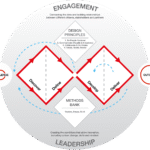
Artificial Intelligence (AI) is rapidly transforming various aspects of our lives, and the realm of creativity is no exception. The emergence of powerful AI tools like ChatGPT in 2022 has sparked great interest among researchers exploring the intersection of AI and creativity.
Researchers worldwide are delving into the nature of creativity, both human and machine-generated, and exploring how we value work produced by both.
In this regard, researchers from Yale University and Harvard University discuss co-creation or the use of AI as a tool that could enhance human creativity.
A Spectrum of Creativity
The analogy with past technological advances is particularly enlightening. Just as photography gave birth to a new form of art, AI has the potential to unlock new creative pathways that we can barely begin to imagine. Similar to how computers revolutionized scientific research, AI can enable us to explore creative possibilities beyond the limitations of human cognition.
On the other hand, the scientific literature reports that creativity manifests in various forms, ranging from everyday ingenuity (little-c) we use in daily life to revolutionary innovations (Big-C) that shape history. Kaufman and Beghetto’s (2009) Four C’s framework provides a useful lens for understanding this spectrum:
- Mini-c: The fundamental building block, encompassing basic cognitive processes like fluency and flexibility.
- Little-c: Everyday creativity, evident in problem-solving, cooking a new dish, or writing a creative email.
- Pro-c: Professional or domain-specific creativity, involving expertise within a particular field.
- Big-C: Highly original and impactful creativity leading to significant contributions to a field.
AI as a Co-Creation Partner
AI, broadly defined to include not only advanced language models like ChatGPT but also various computer programs aiding tasks requiring human intelligence, can potentially enhance creativity.
Researchers focus on the co-creation scenario or the use of AI as a creativity tool, considering a broad view of AI that includes any computer program performing tasks normally understood to require human intelligence.
In this sense, the study’s authors present relevant emerging research on how AI can be utilized across a continuum of four creativity levels:
- Mini-c: AI can personalize learning experiences, adapting them to individual needs and learning styles, fostering a more creative approach to knowledge acquisition; for example, learning towards mastering reading and writing.
- Little-c: AI tools can assist with brainstorming, generating diverse ideas, and providing unexpected perspectives, igniting creativity sparks in everyday problem-solving; for example, leisure activities, daily challenges in relationships or work.
- Pro-c: Professionals can leverage AI for tasks like data analysis, content generation, and design exploration, freeing up their time and cognitive resources to focus on higher-level creative thinking and strategic decision-making; for example, published writings, exhibited artworks, significant creative contributions at work, founding businesses or organizations.
- Big-C: While Big-C creativity remains exclusively human, AI can still play a supportive role by aiding research, data analysis, and even prototype development, potentially accelerating the creative process of innovative thinkers. The study cites the use of AlphaFold, AI designed to predict the 3D structure of proteins based on their genetic sequence.
Looking Ahead: A Future Full of Potential
Researchers note that “research on AI systems as tools for human creativity is in its infancy, although broader research on human-computer interaction and specifically creativity-support tools has a long history.”
Thus, the exploration of AI and creativity conducted in the study is just the beginning. The study’s authors recommend that future research should delve into specific applications of AI tools in various creative fields. Additionally, ethical considerations regarding authorship, ownership, and potential biases in AI-generated outcomes will require careful exploration.
As we move forward, embracing joint creation between humans and AI promises to unlock unprecedented creative potential, shaping a future where human ingenuity and machine intelligence work together to expand the boundaries of what is possible.
Contact
Zorana Ivcevic
Yale Center for Emotional Intelligence, Yale University, 350 George St., New Haven, CT 06511, United States
Email: Zorana.ivcevic@yale.edu
Reference (open access)
Ivcevic, Z., & Grandinetti, M. (2024). Artificial intelligence as a tool for creativity. Journal of Creativity, 100079.
Editor and founder of “Innovar o Morir” (‘Innovate or Die’). Milthon holds a Master’s degree in Science and Innovation Management from the Polytechnic University of Valencia, with postgraduate diplomas in Business Innovation (UPV) and Market-Oriented Innovation Management (UPCH-Universitat Leipzig). He has practical experience in innovation management, having led the Fisheries Innovation Unit of the National Program for Innovation in Fisheries and Aquaculture (PNIPA) and worked as a consultant on open innovation diagnostics and technology watch. He firmly believes in the power of innovation and creativity as drivers of change and development.





